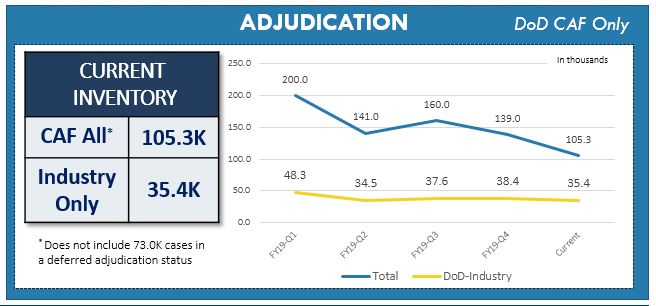
Continuous evaluation enrollment will more than double in 2020, DoD says
In anticipation of several new policy directives in the coming months, the Defense Counterintelligence and Security Agency is planning to dramatically ramp up...
Best listening experience is on Chrome, Firefox or Safari. Subscribe to Federal Drive’s daily audio interviews on Apple Podcasts or PodcastOne.
The Trump administration is planning to dramatically ramp up the number of people it has enrolled in continuous evaluation programs next year.
The Defense Counterintelligence and Security Agency expects continuous evaluation enrollment will reach 3.6 million — more than double the 1.4 million clearance holders currently enrolled in the Pentagon’s CE program — by the end of 2020, said Ned Fish, deputy director for DCSA’s defense vetting directorate.
Enrollment will likely be contingent on at least three major upcoming policy directives, which defense and intelligence officials say are “imminent.” They’re designed to kick-start a broad overhaul of the suitability, credentialing and security clearance system under an initiative called Trusted Workforce 2.0.
As Federal News Network reported last week, the president is expected to first sign a national security memo, which will direct both the Office of the Director of National Intelligence and the Office of Personnel Management to begin suitability, credentialing and security clearance modernization efforts.
An executive correspondence from ODNI and OPM will come next, instructing agencies to officially stop five-to-10-year periodic reinvestigations of their clearance holders and instead move to continuous evaluation capabilities.
“That really sets us up for, in this vetting world is a future goal but not a distant future world, and that is to become really ready for continuous vetting,” Charlie Phalen, DCSA director, said last week at a meeting of the National Industrial Security Program Policy Advisory Council (NISPPAC). “This is one of the biggest sea changes in how we think about trusted people in easily the last 70 years.”
Both DoD and the ODNI have their own continuous evaluation programs.
The DoD program pulls in unclassified information though a series of automated records checks. It will eventually pull in some data feeds from ODNI’s own continuous evaluation program, which ODNI operates as a shared service to a variety of agencies.
The ODNI program alerts agencies to potential red flags on a clearance holder’s credit or financial transactions. It also searches for suspicious transactions, foreign travel or potential links to terrorism, as other examples.
This enhanced continuous evaluation program is what defense and intelligence officials have coined as “continuous vetting,” or “continuous evaluation-plus.” Those kinds of checks on the cleared population will continue in the future state of continuous vetting. What will change, however, is how often DoD and ODNI perform those checks.
Today, most clearance holders are generally reviewed once every five-to-ten-years. But as continuous vetting replaces periodic reinvestigations entirely, DoD will have a near-real-time look at its trusted population.
Continuous evaluation’s role in security clearance backlog progress
Continuous evaluation has already paid dividends for DCSA and the National Background Investigations Bureau in two main ways.
First, DCSA and NBIB have been deferring periodic reinvestigations for low-risk clearance holders, instead enrolling them directly into continuous evaluation.
At least 380,000 cases have been deferred and enrolled in continuous evaluation to date, including some 55,000 industry periodic reinvestigations, Fish said.
This has allowed DCSA to lower its security clearance backlog and focus more closely on initial secret and top secret investigations.
Today, the security clearance inventory sits at 267,000, roughly 50,000 shy of what defense officials have described as a “steady state” of 200,000-to-225,000 cases.
Second, the DCSA is using continuous evaluation to defer low-risk, completed periodic reinvestigations that haven’t been adjudicated.
This technique has, in part, taken the pressure off DoD’s Consolidated Adjudications Facility. The backlog at the DoD CAF ballooned to more than 200,000 unprocessed cases at the start of fiscal 2019.

Today, the DoD CAF backlog sits at 105,300 adjudications, according to the DCSA. That total, however, doesn’t include some 73,000 cases whose adjudications have been deferred and enrolled in CE.
“We’re focusing on getting people to work by prioritizing initial adjudications and also be working those cases that actually do have risk in them, CE hits, incident reports and the derogatory [periodic reinvestigations],” Fish said. “If a person is deferred at the adjudication [level], know that that person is in CE, they retain eligibility and there’s little to no risk in that case.”
Beyond the overall backlog, DCSA said continuous evaluation has played a role in reducing overall investigations times.
Investigation and adjudication times for tier 5 initial cases are down an average of 37% for DoD industry, DCSA said.

Phalen said these techniques, along with several other business modernization practices that NBIB used to address its own inventory, have also helped the DoD CAF make some progress on its adjudications backlog.
But for industry and other federal agencies, the prospect of nearly eliminating periodic reinvestigations poses some uncertainty and confusion.
“It’s a cultural thing. [It’s] been beaten into all of us for years: what’s the date of your last background investigation?” one NISPPAC member said. “It is a total culture shock to some people.”
DoD and ODNI acknowledged the concern.
Garry Reid, director of defense intelligence, likened the future state of continuous vetting to a periodic reinvestigation a day.”
Agencies will be responsible for addressing any red flags that might come up through these automated records checks, Valerie Kerbin, an ODNI senior security adviser, said.
And ODNI and DCSA are working to finalize an agreement that will give industry greater visibility into their clearance holders, Phalen said.
Industry, as well as other federal agencies, will be able to track continuous evaluation enrollment in the next version of the Defense Information System for Security.
“You’ll be able to track where and why folks are being enrolled in CE,” Phalen said. “We’ve worked out an arrangement with the DNI to be able to let other agencies understand why people are in our CE program, why we have deferred some of those periodic reinvestigations and not penalize people who have been put in deferral status.”
Copyright © 2025 Federal News Network. All rights reserved. This website is not intended for users located within the European Economic Area.
Nicole Ogrysko is a reporter for Federal News Network focusing on the federal workforce and federal pay and benefits.
Follow @nogryskoWFED



